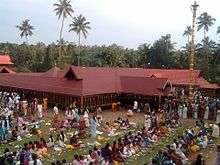Thrikkadavoor

| Thrikkadavoor തൃക്കടവൂര് കടവൂര് | |
|---|---|
| Zone & Neighbourhood | |
| Kadavoor | |
|
Trikkadavoor Shivaraju | |
 Thrikkadavoor  Thrikkadavoor Location in Kerala, India | |
| Coordinates: 8°55′14.0874″N 76°35′41.2188″E / 8.920579833°N 76.594783000°ECoordinates: 8°55′14.0874″N 76°35′41.2188″E / 8.920579833°N 76.594783000°E | |
| Municipal Corporation | Kollam |
| District | Kollam district |
| State | Kerala |
| Region | Desinganadu |
| Country | Republic of India |
| Government | |
| • Type | Councillor |
| Area | |
| • Total | 14.85 km2 (5.73 sq mi) |
| Population (2014) | |
| • Total | 35,859 |
| Languages | |
| • Official | Malayalam |
| Time zone | IST (UTC+5:30) |
| PIN | 691601 |
| Telephone code | 0474 |
| Vehicle registration | KL-02 |
| Website | Kollam Municipal Corporation |
Thrikkadavoor is a Town and a neighbourhood of Kollam city in the state of Kerala, India.[1]
It is located approximately 5 kilometres north of Kollam city centre and 30 kilometres away from Paravur, Thrikkadavoor has become a bustling urban center, and is now home to educational institutions, five star hotel, local business establishments and major recent real estate ventures
Thrikkadavoor was a separate panchayath till 2015. In May 2015, Government of Kerala have decided to expand City Corporation of Kollam by merging Thrikkadavoor panchayath.[2][3]
Education
Schools
- G.H.S.S Anchalummood, kollam
- S.N.D.P H.S.S Neeravil, Kollam
- LP School Anchalummod
- Lower primary school Mathilil
- LKG & UKG school Mathilil
- St. George Up School Mathilil
- Thrikkadavoor LPS
- Govt ups kureepuzha
- Mariya Agnas English Medium School, Kureepuzha
- Sacred Heart School, Kureepuzha
- N.S.S Centrel School,Kottackakom
Training colleges
- Kasthoorba Gandhi TTI, Mathilil. It is owned by Kasthoorba Gandhi memorial women’s charitable society registered under Travancore Cochin Charitable Society’s Act. About 50 women irrespective of caste, creed or politics are members of the society. This is the only TTI in the state which is run by a women’s organization.
- Nalanda Academy Anchalummood
- KNG Unnithan Study centre, Kadavoor
- Reliance College Anchalummoodu
- ALPHA Study Centre, Kadavoor Link label
Railway Station
- Kollam railway station (6 km)
Mahadeva Temple

Thrikkadavur Mahadeva Temple 5 km northwest of Kollam with golden flag staff, 10 days festival in Kumbhom - Thiruvathira Aaratu. 101 Kudam (pot) Kalasam, Chathussatham are offering. The Thrikkadavoor Mahadeva Temple is the most famous Siva Temple in Kollam District. It is situated in the Thrikkadavoor Panchayath and on the banks of the Ashtamudi lake.Mrikandu rishi and his wife Marudmati worshipped Shiva and sought from him the boon of begetting a son. As a result, he was given the choice of either a gifted son, but with a short life on earth or a child of low intelligence but with a long life. Mrikandu rishi chose the former, and was blessed with Markandeya, an exemplary son, destined to die at the age of 12.
Markandeya grew up to be a great devotee of Shiva and on the day of his destined death he continued his worship of Shiva in his aniconic form of Shivalingam. The messengers of Yama, the god of death were unable to take away his life because of his great devotion and continual worship of Shiva. Yama then came in person to take away Markandeya's life, and sprung his noose around the young sage's neck. By accident or fate the noose mistakenly landed around the Shivalingam, and out of it, Shiva emerged in all his fury attacking Yama for his act of aggression. After defeating Yama in battle to the point of death, Shiva then revived him, under the condition that the devout youth would live forever. For this act, Shiva was thereafter known also as Kalantaka ("Ender of Death"). This was said to have happened in Thirukkadavoor also call Thrikkadavoor. Thus Maha Mrityunjaya Stotra is also attributed to Markandeya,[4] and this legend of Shiva conquering death is inscribed in metal and worshipped at Thirukkadavoor mahadeva temple. The annual Srattu festival attracts thousands of people, including foreigners. The festival falls in the month of Kumbham (February/March). The eight artificial horses, which represent the eight areas (karas) around the temple, is a special attraction for tourists. May be the world's only one Nedumkuthira ( Eduppukuthira- men carrying vertical horse-chariot) procession through water witnessed by global tourists.
Other Temples
- Sri Subramanya swami temple, Mathilil
- Kuppana Sri Murukan Covil, Neeravil
- Panamoodu Sree Bhadra Kali Temple, Neeravil
- Venkekkara devi Temple, Mathilil
- Edavanatt Devi Temple, Mathilil
- Punthala Temple, Mathilil
- Keelattu Sree Shakthi Bhairavi Temple, Kadavoor
- Kunnathuvila bhadra kali temple, kadavoor
- Bhoothakkavu devi temple, kadavoor
- Sree Ayiravillan siva-parvathy temple,kureepuzha
- Ayyankaoiyikkal Sree Dharma shastha tmple,kureepuzha
- Kochu Pathinettam padi Ayyappa temple,kureepuzha
- Thottumkara Sree Bhadrakaali Devi temple,kureepuzha
- Aakkal Sree Parthasaradhi temple,kureepuzha
- Kalariyil Sree Balabhadradevi temple, Kureepuzha
- Plavara Sree Durgadevi temple, Kureepuzha
- Sree Badra Devi Temple,Viraliyil,Kottackakom
Demographics
As of 2001 India census, Thrikkadavoor had a population of 38141 with 18674 males and 19467 females.[1]
References
- 1 2 "Census of India : Villages with population 5000 & above". Registrar General & Census Commissioner, India. Retrieved 2008-12-10.
- ↑ "Thrikadavur becomes part of Kollam city". The Hindu. Retrieved 11 June 2015.
- ↑ "Thrikadavur Panchayath". Thrikadavur Panchayath. Retrieved 11 June 2015.
External links
| Wikimedia Commons has media related to Thrikkadavoor. |